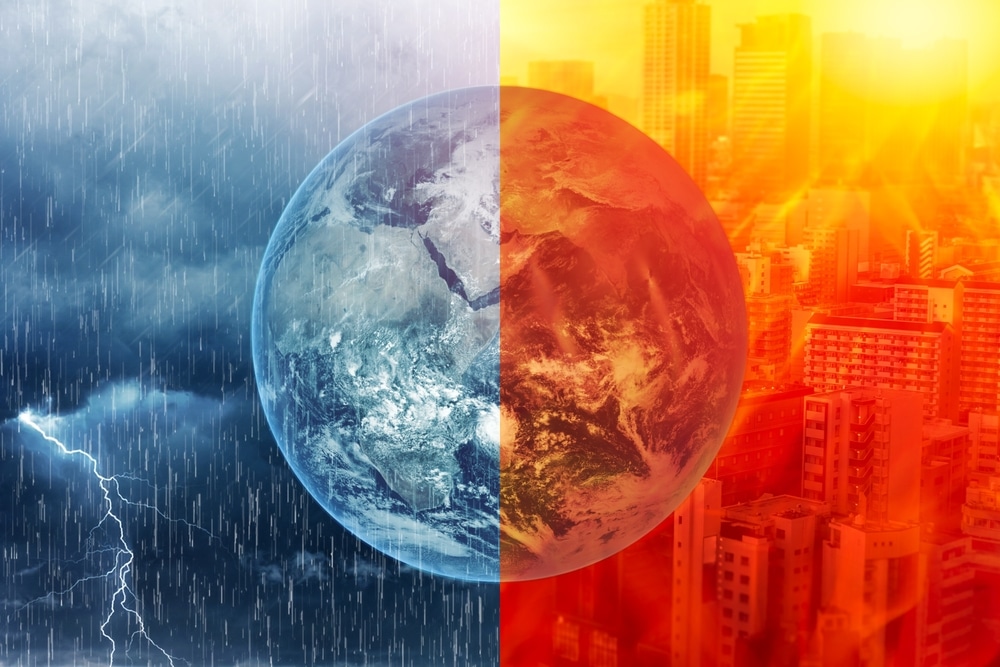Vanishing glaciers. Newly ice-free stretches in the Arctic. Record droughts punctuated by record deluges. A hurricane, supercharged by hot Pacific water, that lasted six weeks.
And across the globe, implacable, record-breaking heat.
In 2023, record production and burning of fossil fuels poured unprecedented amounts of energy into the Earth’s atmosphere and oceans, helping to spur some of the wildest weather in recorded history as the structures that underpin modern human civilization began to buckle in the rising heat.
On Thursday, the American Meteorological Society (AMS) released its annual survey of the state of global climate — a soberly worded account of a world in rapid transition toward a state unlike any humans have ever known.
Here’s what you need to know about the report’s findings on last year’s climate, and what they say about the emerging state of the world.
A world where the weather is getting far hotter and also far more strange.
Last year was the hottest on record, with the average global temperature every month from June to December setting all-time highs. Meanwhile, the mean ocean temperature for the year — a number that averages the humid tropics and the frigid Arctic and Antarctic — hit a record 66 degrees Fahrenheit (18.99 Celsius).
Because added heat is, fundamentally, added energy — and above all, added ability for air to trap water — the warming helped drive a cavalcade of new disasters, from hurricanes to sudden deluge to drought.
The North Atlantic had its seventh straight above-normal hurricane season, while the Pacific was marked by a new level of destructive storms.
The Pacific Tropical Cyclone Freddy became the longest-lived tropical cyclone on record, lasting for five weeks between Feb. 6 and March 12. Throughout that time, the storm stayed intact as it crossed the entire Indian Ocean and made three separate landfalls in Mozambique and Madagascar.
On the other side of the ocean, Hurricane Otis strengthened from a Category 1 to a Category 5 in just nine hours — a record — to become the strongest hurricane ever to make landfall on the west coast of North America.
Punctuated events such as those storms are a mark of what Texas Tech University climate scientist Katharine Hayhoe has called “global weirding” — the way in which planetary heating interacts with a chaotic global climate to drive results that are rapid, unexpected or mash together extremes.
For example: drought and floods coinciding. Last year saw one of the lowest records of global precipitation in the more than 40 years since records began — but an above-average level of 1-day maximum rainfalls, “indicating a rise in rainfall intensity,” the AMS report noted.
For example, the AMS pointed to the record 30 inches that fell on Beijing in August 2023 within less than two days, killing 137 people.
Meanwhile, Greece experienced both its highest daily rainfall on record — 30 inches, or a year’s worth of rain, in a single 24-hour period — and the largest wildfire in the European Union’s history.
The AMS pointed to other strange phenomena: the supercell thunderstorm in northern Italy that dropped a hailstone more than 7 inches in diameter, breaking the European record for hail size, and the Japanese cherry blossoms that bloomed at the earliest time in the 125-year record.
This weirdness was sometimes devastating, as in the case of the Beijing flooding, but also occasionally sweet. For the first time in recorded memory, foragers found ripe cloudberries in Norway’s frigid Svalbard archipelago.
“I hardly believed my own eyes,” Stein Tore Pedersen of the Norwegian Polar Institute, who found the ripe berries while reindeer hunting, told The Barents Observer.
A combination of human action and natural forces that serve to trap heat energy inside the Earth’s atmosphere, land mass and oceans.
Heat from the sun is being trapped by planet-warming gasses emitted by human civilization, largely in the form of methane and carbon dioxide from the burning of coal, oil and gas — though agriculture also plays a significant role.
Last year, the AMS found that the global carbon dioxide concentration hit 420 parts per million, or 50 percent greater than preindustrial levels.
That rate of growth, and therefore heating, is accelerating. The level of carbon dioxide increase between 2022 and 2023 was 12 percent higher than that of the last decade — and five times greater than that of the 1960s.
Last year, that warming was exacerbated by the shift from the cooler La Niña to the hotter El Niño system, which drove temperatures up more.
And in addition to global cycles and more heat-trapping pollution, another factor is causing temperatures to go up: the reduction in shade. Last year was the least cloudy since records began in 1980, leading to “the weakest cooling effect of clouds on record,” per the AMS.
Making that effect more powerful: Human civilization is now letting in more sunlight as a consequence of efforts to clean up global shipping and coal production.
While these campaigns have made the air cleaner, removing pollutants like sulfur dioxides from the atmosphere allows more of the sun’s heat energy into the earth because such contaminants previously reflected that heat back into space.
In 2021, former NASA scientist James Hansen argued that the Earth was warming too fast to be explained by emissions alone, and estimated that the cleanup of the atmosphere was accelerating the rate of global heating.
But by how much? Fifty percent, he argued in a 2023 paper he co-published in Oxford Open Climate Change — or from a global average of about one-third of a degree Fahrenheit to about half of a degree per decade.
Hansen’s team estimated that when added to heating driven by current fossil fuel consumption, that rate would be fast enough to blow through the Paris Climate Accord’s ideal warming limit — 1.5 degrees Celsius or 2.7 degrees Fahrenheit over preindustrial levels, the benchmark at which scientists fear the most serious climate-warming impacts will begin to appear — by the end of this decade.
And they estimated that Earth would surpass the red line of 2 degrees Celsius (3.6 degrees Fahrenheit) by 2050.
The additional heat in the system has to go somewhere. One principal place it is going is the oceans, which cover 71 percent of the planet’s surface and absorb about one-third of human emissions — as well as a lot of the additional solar heat that carbon and methane pollution trap. The resulting rise in ocean temperatures drives stronger storms, droughts that suck the moisture from entire landscapes and more rainfall.
First, they drove a lot of additional episodes of death and destruction, like the 52 deaths and $16 billion in damage caused by Hurricane Otis, or the 102 deaths in the fires in Maui, the U.S.’s deadliest wildfires in a century.
The shifts in the climate also contributed to the continued — and accelerating — sea level rise, as the ice sheets melt, adding water to the oceans, and as those oceans themselves warm, causing them to take up more space.
The AMS found that average global sea levels in 2023 were 6 inches higher than in 1990 — marking an implacable rise that by last year had reached a rate of about one-third of an inch per year on average.
That increase is speeding up over time, the AMS noted: Sea levels rose three times faster in 2022-2023 than over the last 30 years.
Higher seas mean worse storm surge damage and flood risk for coastal regions, which house more than 40 percent of human civilization.
And as laid out by the AMS, climate change is not just bringing on more disasters or higher seas, but also disasters of new and different kinds than those societies may be set up to deal with: heat waves and ice storms in places that aren’t used to them, as well as an increased incidence of compound disasters.
It is also reshaping once-permanent features of the environment — starting with the subset of the Earth’s landscapes known as the “cryosphere,” or the world of glaciers and ice caps.
Last August, for example, a meltlake of water streaming off the Mendenhall Glacier above Alaska’s capital of Juneau broke through an ice dam to flood the city, while the state’s Iceworm Glacier disappeared entirely.
At the same time, that melting drove up the commercial viability of the once-fabled Northwest Passage and Northern Sea Route through the normally ice-choked Arctic Ocean to the Atlantic or Pacific. The Northwest Passage saw a record 42 transits by ships, including 13 cargo ships.
Meanwhile, the Northern Sea Route, which links the Russian Arctic to the Pacific, saw a record 2.1 million tons of cargo shipped — including crude oil.
A major concern is that the Earth’s systems are absorbing the increased heat in ways that are both blunting its immediate effects and, over time, potentially making them worse.
For example, the AMS study identified rising disorder as a consequence of increasing heat — something climate scientists worry can also contribute to further heating in a worsening and self-reinforcing cycle.
The report found evidence of this sort of decay in several Earth systems that are seen as essential stabilizers of the climate — which, if they change enough, could cause warming to increase even faster.
The retreat of the cryosphere, for instance, is removing landscapes that otherwise reflect heat back into space. The area of greatest concern in this regard is the Antarctic, which in 2023 was 4 to 10 degrees Fahrenheit (2 to 6 degrees Celsius) hotter than average, and saw all-time record lows in sea-ice extent, according to the AMS.
The AMS also found troubling patterns in global forests.
Trees are largely made of carbon dioxide pulled from the atmosphere — and they have been growing faster as the concentration of the gas in the atmosphere has increased, helping balance the climate.
But last year saw evidence that this pattern of absorption was reversing as wildfires in several significant regions belched plumes of carbon dioxide back into the atmosphere, at least temporarily changing many forests into a contributor to warming, rather than a bulwark against it.
As the AMS report noted, Canada’s vast boreal forest burned for an unprecedented length of time, and at a scale that doubled past records — leading to a quarter-million evacuations. Meanwhile, in the Amazon, more than 22,000 fires were recorded.
These are both signs that systems that once drove the earth toward stability could start to drive heating.
One other system that concerns climate scientists is the planet’s nearly 9 million square miles of global permafrost — ever-frozen Arctic landscapes full of the frozen bodies of plants and animals half-digested by microbes.
As the permafrost melts due to rising temperatures, these corpses decay further, releasing methane, which heats the climate dozens of times faster than carbon dioxide. In 2023, AMS noted record-high temperatures in the permafrost across more than half of the Arctic sites tested, which could translate into emissions from the tundra beginning to increase.
These changes all signal Earth’s potential movement into a new climate paradigm, and out of the temperate Holocene, or the geologic age in which humans evolved.








